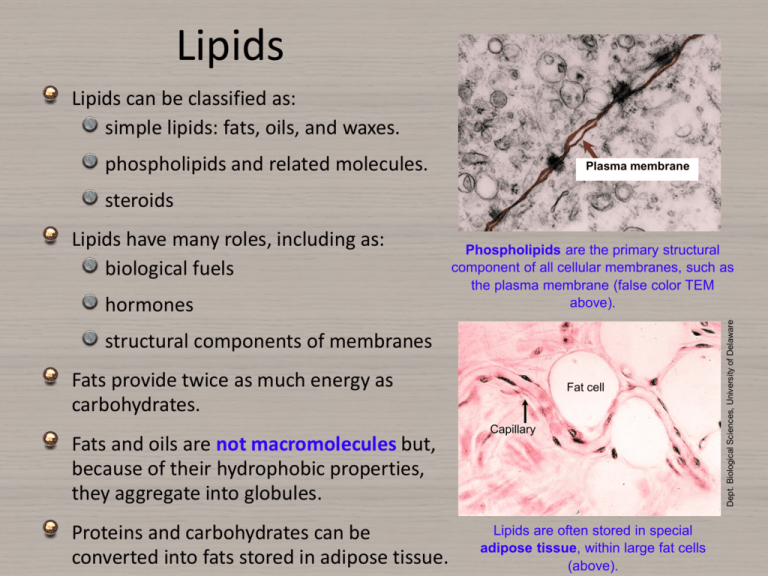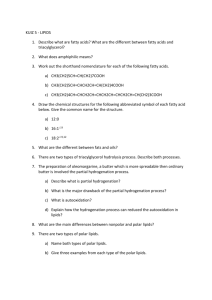Lipids
advertisement

Lipids Lipids can be classified as: simple lipids: fats, oils, and waxes. phospholipids and related molecules. Plasma membrane steroids hormones Phospholipids are the primary structural component of all cellular membranes, such as the plasma membrane (false color TEM above). structural components of membranes Fats provide twice as much energy as carbohydrates. Fats and oils are not macromolecules but, because of their hydrophobic properties, they aggregate into globules. Proteins and carbohydrates can be converted into fats stored in adipose tissue. Fat cell Capillary Lipids are often stored in special adipose tissue, within large fat cells (above). Dept. Biological Sciences, University of Delaware Lipids have many roles, including as: biological fuels Biological Roles of Lipids Mitochondrion (false color TEM) Lipids are concentrated sources of energy and can be broken down (through fatty acid oxidation in the mitochondria) to provide fuel for aerobic respiration Waxes and oils, when secreted on to surfaces provide waterproofing in plants and animals. Phospholipids form the structural framework of cellular membranes, e.g. the plasma membrane (above). Biological Roles of Lipids The white fat tissue (arrows) is visible in this ox kidney Fat absorbs shocks. Organs that are prone to bumps and shocks (e.g. kidneys) are cushioned with a relatively thick layer of fat. Lipids are a source of metabolic water. During respiration, stored lipids are metabolized for energy, producing water and carbon dioxide. Stored lipids provide insulation in extreme environments. Increased body fat levels in winter reduce heat losses to the environment. Fats and Oils The most common lipids in living things are the neutral fats. They make up the fats and oils found in plants and animals. Fats and oils are formed by condensation reactions between fatty acids and glycerol to form ester links (– COO–). One fatty acid = monoglyceride Two fatty acids = diglyceride Three fatty acids = triglyceride or triacylglycerol. Triacylglycerols are the most common of these. Water is lost to form an ester bond O H H C Globules of fat or oil are compact and relatively inert OH OH C CH2 CH2 CH2 CH2 CH2 CH2 CH2 CH2 CH2 CH2 CH2 CH2 CH2 CH2 CH2 CH2 CH2 O H C OH OH C CH2 CH2 CH2 CH2 CH2 CH2 CH2 CH2 CH2 CH2 CH2 CH2 CH2 CH2 CH2 CH2 CH2 O H C OH OH C CH2 CH2 CH2 CH2 CH2 CH2 CH2 CH2 CH2 CH2 CH2 CH2 CH2 CH2 CH2 CH2 CH2 H Glycerol Three fatty acids Fats and Oils The difference between fats and oils is their physical state at 20°C. Oils are liquid at room temperature, while fats are solid Fats are solid at 20°C. Oils are liquid at 20°C These differences in the physical properties of fats and oils are a result of the type of fatty acid attached to the glycerol molecule. The fatty acids making up triacylglycerols are long unbranched hydrocarbon chains (CH3(CH2)n –), ending with a carboxylic acid (–COOH). Palmitic acid: a saturated fatty acid Some are saturated fatty acids, with a maximum number of hydrogen atoms. Some are unsaturated, with double bonds and fewer hydrogen atoms. Linoleic acid: a saturated fatty acid Saturated Fatty Acids Saturated fatty acids contain the maximum number of hydrogen atoms. They do not contain any double bonds or other functional groups along the chain. Saturated fatty acids form straight chains. Lipids containing a high proportion of saturated fatty acids tend to be solids at room temperature, i.e. fats, such as butter and lard. O H H H H H H H H H H H H H H H C C C C C C C C C C C C C C C C H H H H H H H H H H H H H H H Palmitic acid is a saturated fatty acid. All of the spaces on the carbon bonds are filled by hydrogens, which results in a straight chain molecule, as shown in the space filling model (right). H Unsaturated Fatty Acids Unsaturated fatty acids contain some carbon atoms that are doublebonded with each other (all of the spaces are not taken by hydrogen atoms). Lipids with a high proportion of unsaturated fatty acids are oils and tend to be liquid at room temperature. The unsaturated nature causes kinks in the straight chains. When aligned in a lipid molecule, the kinked fatty acids do not pack in closely together; hence the more fluid structure of oils. O H H H H H H H H H H H H H H H H H H C C C C C C C C C C C C C C C C C C C H H H H H H H H H H H H H H Linoleic acid is an unsaturated fatty acid. The double bonds between the carbon atoms prevent bonds to hydrogen. The double bonds produce a kink in the chain as shown on the space filling model (right). Kink H Phospholipids If one of the fatty acid groups of a triglyceride is replaced by a phosphate group, the the molecule is known as a phospholipid. A phospholipid consists of: a glycerol molecule two fatty acid chains a phosphate (PO43-) group (ionised under the conditions in cells) H2C HC Nonpolar, hydrocarbon tails of two fatty acids condensed with glycerol COO COO O– H2C O P O– Fatty acid Phosphate group from phosphoric acid (HPO4) condenses with the third -OH of glycerol Glycerol O PO43- Fatty acid Symbolic representation of a phospholipid Phospholipids The phosphate end of the molecule is polar and attracted to water (hydrophilic) while the fatty acid end is non-polar and is repelled (hydrophobic). As a result, phospholipids naturally form a bilayer with the hydrophobic ends orientated inwards. The phospholipid bilayer forms the main component of cellular membranes. Glycerol and phosphate ‘head’: the hydrophilic part of the molecule Hydrocarbon tail: hydrophobic part of the molecule. Steroids Steroids are classified as lipids, but their structure is quite The basic structure of a steroid(shown symbolically above) is three six carbon atom rings, and one five carbon atom ring. different from that of other lipids. The basic structure of a steroids is: three 6 carbon atom rings one 5 carbon atom ring. Examples of steroids include: sex hormones (testosterone and estrogen) hormones such as cortisol and aldosterone cholesterol is a sterol lipid and is a precursor to several steroid hormones. Steroid sex hormones are responsible for both primary and secondary sexual characteristics in males and females. Lipid Condensation Water is lost to form an ester bond Triglycerides form when glycerol bonds with three fatty acids. Glycerol is an alcohol containing three carbons. Each carbon is bonded to a hydroxyl (–OH) group. H H O H OH C CH2 CH2 CH2.............CH3 O H C O H + OH C CH2 CH2 CH2.............CH3 O H C O H OH C CH2 CH2 CH2.............CH3 H When glycerol bonds with the fatty acid, an ester bond is formed and water is released. Glycerol H H Three separate condensation reactions are involved in producing a triglyceride. C O C Three fatty acids O O C CH2 CH2 CH2.............CH3 + H2O CH2 CH2 CH2.............CH3 + H2O CH2 CH2 CH2.............CH3 + H2O O H C O C O H C O C H Triacylglycerol (triglyceride) Water






